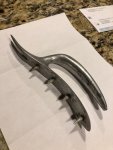Colo
500+ Posts
I am not sure this is a new game for us or not because I am clueless what the right answer is...
A friend bought this item at an auction this weekend for $1 USD.
It is stamped Italy.
He has no idea what it is and neither do I.
Can anyone identify this item and what it is used for?

A friend bought this item at an auction this weekend for $1 USD.
It is stamped Italy.
He has no idea what it is and neither do I.
Can anyone identify this item and what it is used for?

